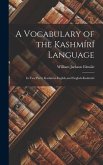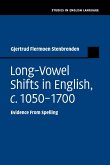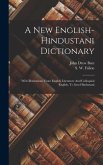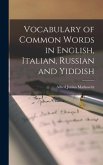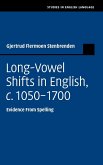This volume describes the development of Standard English from Middle English onwards.
There are many questions yet to be answered about how Standard English came into existence. The claim that it developed from a Central Midlands dialect propagated by clerks in the Chancery, the medieval writing office of the king, is one explanation that has dominated textbooks to date. This book reopens the debate about the origins of Standard English, challenging earlier accounts and revealing a far more complex and intriguing history. An international team of fourteen specialists offer a wide-ranging analysis, from theoretical discussions of the origin of dialects, to detailed descriptions of the history of individual Standard English features. The volume ranges from Middle English to the present day, and looks at a variety of text types. It concludes that Standard English had no one single ancestor dialect, but is the cumulative result of generations of authoritative writing from many text types.
Review quote:
'The Development of Standard English, 1300-1800 provides thought-provoking insights into the past of standard English. I strongly recommend it to anyone interested in a refreshing re-examination of the teaching of the story of this language.' International Trade
Table of contents:
List of contributors; Acknowledgements; Introduction Laura Wright; Part I. Theory and Methodology: Approaches to Studying the Standardisation of English: 1. Historical description and the ideology of the standard language Jim Milroy; 2. Mythical strands in the ideology of prescriptivism Richard J. Watts; 3. Rats, bats, sparrows and dogs: biology, linguistics and the nature of Standard English Jonathan Hope; 4. Salience, stigma and standard Raymond Hickey; 5. The ideology of the standard and the development of Extraterritorial Englishes Gabriella Mazzon; 6. Metropolitan values: migration, mobility and cultural norms, London 1100-1700 Derek Keene; Part II. Processes of the Standardisation of English: 7. Standardisation and the language of early statutes Matti Rissanen; 8. Scientific language and spelling standardisation 1375-1550 Irma Taavitsainen; 9. Change from above or below? Mapping the loci of linguistic change in the history of Scottish English Anneli Meurman-Solin; 10. Adjective comparison and standardisation processes in American and British English from 1620 to the present Merja Kytö and Suzanne Romaine; 11. The Spectator, the politics of social networks, and language standardisation in eighteenth-century England Susan Fitzmaurice; 12. A branching path: low vowel lengthening and its friends in the emerging standard Roger Lass; Index.
There are many questions yet to be answered about how Standard English came into existence. The claim that it developed from a Central Midlands dialect propagated by clerks in the Chancery, the medieval writing office of the king, is one explanation that has dominated textbooks to date. This book reopens the debate about the origins of Standard English, challenging earlier accounts and revealing a far more complex and intriguing history. An international team of fourteen specialists offer a wide-ranging analysis, from theoretical discussions of the origin of dialects, to detailed descriptions of the history of individual Standard English features. The volume ranges from Middle English to the present day, and looks at a variety of text types. It concludes that Standard English had no one single ancestor dialect, but is the cumulative result of generations of authoritative writing from many text types.
Review quote:
'The Development of Standard English, 1300-1800 provides thought-provoking insights into the past of standard English. I strongly recommend it to anyone interested in a refreshing re-examination of the teaching of the story of this language.' International Trade
Table of contents:
List of contributors; Acknowledgements; Introduction Laura Wright; Part I. Theory and Methodology: Approaches to Studying the Standardisation of English: 1. Historical description and the ideology of the standard language Jim Milroy; 2. Mythical strands in the ideology of prescriptivism Richard J. Watts; 3. Rats, bats, sparrows and dogs: biology, linguistics and the nature of Standard English Jonathan Hope; 4. Salience, stigma and standard Raymond Hickey; 5. The ideology of the standard and the development of Extraterritorial Englishes Gabriella Mazzon; 6. Metropolitan values: migration, mobility and cultural norms, London 1100-1700 Derek Keene; Part II. Processes of the Standardisation of English: 7. Standardisation and the language of early statutes Matti Rissanen; 8. Scientific language and spelling standardisation 1375-1550 Irma Taavitsainen; 9. Change from above or below? Mapping the loci of linguistic change in the history of Scottish English Anneli Meurman-Solin; 10. Adjective comparison and standardisation processes in American and British English from 1620 to the present Merja Kytö and Suzanne Romaine; 11. The Spectator, the politics of social networks, and language standardisation in eighteenth-century England Susan Fitzmaurice; 12. A branching path: low vowel lengthening and its friends in the emerging standard Roger Lass; Index.


